
is among designs being seriously debated for
SE Powell east of I-205.
(Photo: J.Maus/BikePortland)
Bike lanes separated by a low curb and/or Copenhagen-style raised bike lanes continue to look likely for parts of Powell Boulevard between Interstate 205 and 172nd Avenue.
At least, that’s the word from Paul Grosjean, the co-chair of the Outer Powell Community Advisory Group and a member of the Outer Powell Decision Committee, both part of the state-run Outer Powell Safety Project.
“Separation between the bike and the travel lane has been a priority of all the committees,” Grosjean, who also serves as vice chair of the Pleasant Valley Neighborhood Association, said in an interview Monday.
“Where appropriate, the stronger separations should be expected in the final plan.”
— Paul Grosjean, co-chair of the Outer Powell Community Advisory Group
The news is significant because Powell stands a chance of gradually becoming an important commercial main street for East Portland, and also because Powell could become one of the first state highways in the country to get physically separated bike lanes. One important stretch of Powell, between SE 122nd and 136th avenues, won $17 million for improvements this spring thanks to a last-minute bill in the state legislature, so any decisions made now are likely to result in relatively rapid change.
In the interview, Grosjean said bike lane separation “was the major topic of discussion at both the citizens advisory group meeting and the decision committee meeting over the last four weeks or so” and that the desire for “bicycle corridor success” was probably even stronger on the Decision Committee he sits on than on the citizens’ committee he co-chairs.
That said, Grosjean said he expected that some stretches of the street, which is also a state highway and a significant trucking route, would have a simple striped buffer.
“One of the major concerns is that there is long distances in that corridor that are served with numerous driveways because there are so many residences that face Powell directly,” Grosjean said. “You might end up that 50 or 60 percent of the street being openings for the driveways.”
Despite the talk about bike facilities, there’s also wide agreement that complete sidewalks on the street (which currently lacks any for most of this length) are outer Powell’s single most important need. In some narrower parts of the street, the bike lane quality might be a lower priority.
“Where appropriate, the stronger separations should be expected in the final plan,” Grosjean said. “I would be shocked if that appeared throughout the majority of the corridor, because it wouldn’t be appropriate.”
Would mountable curbs be enough to improve biking on Powell?
Another consideration: whether raised bike lanes with three-inch sloped curbs, like the ones on NE Cully or SW Multnomah boulevards, are enough to actually make biking comfortable on Powell.
“Especially if it’s a mountable curb, it doesn’t really do anything — it can be easily traversed by cars,” said Portland Bicycle Coordinator Roger Geller, who was involved in preparing a rough sketch of a different alternative: a low curb that sits in the buffer between bike and car traffic.
Advertisement
Geller cited the new Separated Bike Lane Design Guide published this fall by the Massachusetts Department of Transportation, which he said doesn’t categorize raised bike lanes as a truly separated bike lane unless there is actual space between bikes and cars.
Geller said the Cully and Multnomah designs had been modeled after streets in Denmark, where a raised bike lane would be a possible treatment on a street resembling outer Powell. But unlike on Cully and Multnomah, outer Powell isn’t expected to have on-street parking spaces to further buffer the lane. And outer Powell, Geller said, isn’t “in a country where almost everybody who’s driving a car is also at some point riding a bicycle.”
Even so, Geller said, his sense of the current conversation about outer Powell’s future bike lanes isn’t whether there should be physical separation between cars and bikes, but “what would the nature of that physical separation be — that’s really what we’re talking about.”
ODOT staff will make final design decision
Mike Mason, a project manager for the Oregon Department of Transportation assigned to this project, didn’t say anything inconsistent with Grosjean’s summary of the committees’ positions.
But Mason noted that “we certainly haven’t made any decisions” and emphasized that neither the advisory committee or decision committee are actually tasked with selecting a design for the bike lane. Instead, he said, their job is to make recommendations and decisions about “environmental” issues like roadway width, noise, biological and wetland impacts.
“The process was not to decide on a specific treatment for the bike facility,” Mason said. “That requires doing some more detailed design work. It requires having the funding to know what the different options would cost. It would require really knowing do they require more right-of-way. … And then there’s maintenance concerns with different facilities. … We need to be able to plow in the winter and remove debris at other times of the year and then have access to the stormwater system.”
The “project team” of ODOT staff will ultimately decide on the street design, Mason said.
“We need to have more information to make that decision,” he said. “So that’s what we’ll be doing probably over the next — and I’m just going to throw this out there — three to six months.”
I asked Grosjean about this tweet last week from Bicycle Transportation Alliance Advocacy Director Gerik Kransky:
I'm hearing reports of @OregonDOT staff working to prevent protected bike lanes from being built on Outer Powell: https://t.co/8p13riHJJq
— Gerik Kransky (@gerikkransky) December 16, 2015
Grosjean said he hasn’t picked up any explicit ODOT skepticism of protected bike lanes on Powell.
“We have ODOT people who are working with us on the advisory committee, and the district 1 chief mucketymuck is on the decision committee,” Grosjean said (referring to ODOT’s manager for the Portland region, Rian Windsheimer). “Through my eyes and ears, that’s not my impression.”
Finally, I asked Grosjean whether he thought there was any chance that ODOT might never get around to asking the Community Advisory Group or Decision Committees for their explicit positions about bike facility design.
Grosjean said he expected the committees will get a chance to make their recommendations known.
“I’m an unpaid volunteer, but I’m not shy at meetings if I don’t think it’s going in the right direction,” he said.
— Michael Andersen, (503) 333-7824 – michael@bikeportland.org


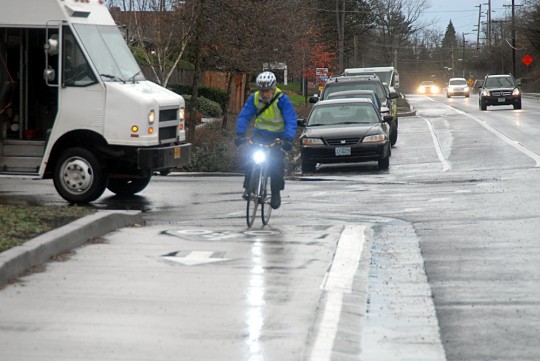
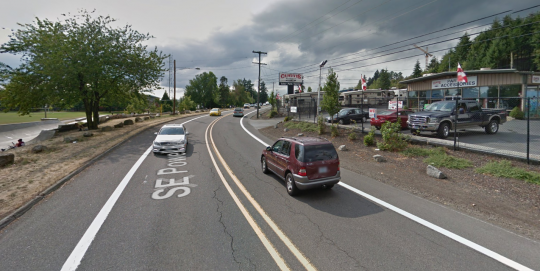

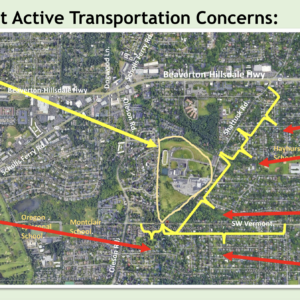
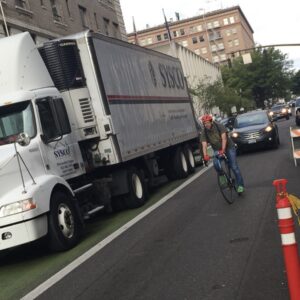
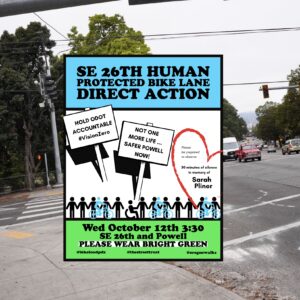
Thanks for reading.
BikePortland has served this community with independent community journalism since 2005. We rely on subscriptions from readers like you to survive. Your financial support is vital in keeping this valuable resource alive and well.
Please subscribe today to strengthen and expand our work.
We need way better infrastructure than a slightly raised lane (at best). That section of Powell is way too dangerous to have anything but fully separated lanes.
“But unlike on Cully and Multnomah, outer Powell isn’t expected to have on-street parking spaces to further buffer the lane.”
A treatment that is considered sub-par in Denmark and the Netherlands because it is associated with increased risk for people cycling.
I should also note that unless Powell is going to be signed at 25-30 mph, a curbed bikeway would not be considered in Denmark. There are two simple solutions to this issue: speed reduction and traffic calming or full separation. I prefer the former.
I also prefer speed reduction to separation. The more separation, the more problematic things like left turns and dealing with traffic entering and leaving the roadway become. Also, it can be mighty trying, actually dangerous, riding a tandem with or without a trailer on separated facilities. We don’t design roadways for only mid-size sedans, so why should cycling facilities be adequate for only single bikes?
With speed reductions, it becomes much easier and safer for all users to make their way down the road. What’s not to like? It’s not like it’s going to take much longer to get there with a 25 mph speed limit than it would with a 40 mph limit. It’s mostly the time spent stopped that affects the time, not the peak speeds.
Yes. The trouble with SW Multnomah is that it’s a street born from a freeway exit and even the ridiculously high speed limit (45?) isn’t enforced. The intersections are not much better than with a painted lane, especially not after ducking behind three parked cars right before a busy right turn location. The eastbound lane is just a sidewalk though, riddled with dips as it crosses every driveway at the wrong grade, so please don’t build more of that “separated infrastructure” where bikes don’t even have the right of way across a driveway at speed. So, how would the Dutch or Danes design a separated bikeway which crosses a driveway every 30ft next to 50mph traffic?
SW Multnomah is posted 35 mph out to SW 45th, then 40 mph.
West of 40th, the 85th percentile is 37-41 mph. West of 25th, it’s 40-42 mph.
For the 1644 feet of shared path on the south side of SW Multnomah, I count six driveways. Five are clustered west of 28th.
Is it misperception, or misinformation, your version of reality?
As for the other popular culture frequently cited, as with PBOT draft recommendations, any road that is desired to be posted higher than 40 mph should have separate bike space, separated from auto traffic, with an impermeable barrier between the bike and auto lanes.
No bike lane = 20 mph max posting
bike lane = 30 mph max posting
bike lane + permeable barrier = 40 mph max posting
That’s 4 driveways and 2 crosswalks in under 800ft from 31st to 28th. Have you ridden on it? You might notice that the roadway doesn’t dip down at each driveway and crosswalk. At 15mph, that’s 6 dips in 35s, or about one every 6 seconds if they were evenly spaced. While it’s not impossible to ride at 20mph, “not impossible to ride” should not be our standard for giving priority to active transportation. Meanwhile, unless you can cite case law to the contrary, I believe Oregon law would go against a person on a bike for a collision at any one of these driveways if they were traveling faster than “a walking pace.” This is bad bikeway design, even for a kid at 5-8mph.
How fresh is your speed data? The portlandmaps site shows the speed limit is posted 45, which seems to be what I remember seeing posted. Even so, 35 is a ridiculously high limit and 40+mph traffic is not inviting for traveling alongside a mountable curb with kids on a bike. In my opinion, anything over 20mph at 35th and Multnomah is irresponsible with people walking, lots of turning traffic, and on-street parking. I have yet to drive the western stretch of Multnomah without seeing someone drive into the bike lane at 50mph.
Perception? I haven’t stood on-site with a radar gun, but I’ll bet nobody from PBOT or PPB has lately either. I would be shocked if decision makers at both of those bureaus together had biked more miles on this stretch than I have (which is only maybe 10.)
Given the lack of enforcement, and that PBOT knows PPB doesn’t do any speed enforcement until 11mph over, is it really wise to base the separation criteria on posted speeds? Do studies show that 51mph rear-end collisions are survivable on a bike? How about designing for whatever it takes to make a mom and kids feel comfortable enough to leave the minivan at home?
51 mph rear end collisions are “survivable”, if you use a rather loose definition of the word. I survived such a collision with a pickup doing 60 MPH, but I had a bone density at the time roughly the same as concrete and rebar and crushed the cab of the truck with the back of my head. Now for someone else who hadn’t survived two previous wrecks with pickup trucks, yeah, probably not.
In Eric’s defense, the section he referenced was 45 until just recently (but well after the new bikeway put in). And his “misperception” matches my perception of reality. Speed isn’t enforced (as with most roads), people use the Westbound end of the bikeway as a parking lane or turn lane when taking a right on 31st, and the Eastbound shared section is quite lumpy when crossing driveways. It looks beautiful in a rendering, but it doesn’t work very well in reality. The neighborhood isn’t quite ready for this treatment; hopefully time will change that. The same might be said for Powell.
Also – I think that in general speed numbers sound less scary than they actually feel on the road. 25mph sounds like a perfectly reasonable speed for a car to go on a neighborhood street, but if you actually see a car going 25mph on a neighborhood street, you say, “Holy crap, that car is going way too fast for this area!” I know because I’ve stood on my street with a radar gun. 35mph or 40mph sounds like a reasonable speed for SW Multnomah, but what the non-paikiala people on this thread are saying is, those speeds feel scary for that area.
At a certain point, traffic engineering needs to take its cues from social science. If a speed or a facility is objectively safe, but scares a large percentage of people off from biking, walking, and taking transit, then the SUBJECTIVE safety needs to take precedence. Biking, walking, and taking transit have such huge public benefits to local health, pollution, economies that objective safety sometimes needs to take second place to subjective safety.
Everything you said is spot on, now we just need to convince ODOT that it’s true.
Speed limits don’t stop cars. Separation does. Something important to consider. Because people are known to NOT follow the speed limit, and enforcement only encourages about 85% compliance if done regularly, which doesn’t happen.
Separation happens ALL THE TIME and also provides a division between motorist and cyclist that is operable 24/7/365 unlike wishing motorists to stay hyper aware and follow the speed limit.
Personally, I’d pick the 24/7/365.
Sure, separation works all the time, except for:
Driveways
Intersections
When you want to turn left
When a door opens on those so-called parking protected lanes
Considering that the two most dangerous locations, door zones and intersections, are made far worse by our current separation options, I’d like to pass on these. Give me a standard (preferably wider than six feet) bike lane clear of the door zone and I’ll happily take my chances with the rare struck from behind in a city risk.
BC,
19% of the historical bike fatal crashes are rear end geometry. Hardly rare.
Geometry is the key word here. Some of those are olbique hits from behind very near intersections or drive ways.
I have had two Portland-Metro friends killed while legally riding in a marked bike lane, by drivers who were not paying attention and drifted over into the bike lane. Both people would be alive today if the raised lane was there. Just sayin’
Take a look, and a measuring tape, at the bike lanes that are in PDX. Many of them are door zone bike lanes, which cut off escape routes, make cyclists harder to see against a camo background of parked cars and, perhaps worst of all, distracts cyclists’ attention from traffic onto sizing up which door is going to open. The remainder are generally too narrow, which again isn’t exactly according to Hoyle, or even our pathetic bicycle facilities guide.
Yes, there are problems with our substandard bike lanes. No argument there. I’m just pointing out that there are even more problems with the separated facilities that have been built and that are being proposed.
Sadly, these problems could all become irrelevant if we just got some traffic law enforcement. Instead of uniting to create this essential bit of the safety infrastructure, we argue over which stripes and gutters are the least bad in a wild-west cars first enforcement regime.
Lamenting that a lot people speed is not an argument against reasonable speed limits. A lot of people (apparently) steal bikes even though it’s against the law, that doesn’t mean we should just do away with that law on the grounds that some people ignore it. If we expect the need for more enforcement then let’s cross that bridge when we get to it, but let’s not give up before we’ve even start.
Unnecessarily high speed limits are a danger to everyone and should be lowered.
How can we cut ODOT out of the loop? How can we shame them into not effing this up? (I mean, we have the skills in PDX to eff this up all on our own.)
By having jurisdictional control transferred without strings attached.
Can the proposed raised bike lane be easily cleared with existing street sweepers?
For the proposed stretch of Powell, are there many residential and/or business driveways?
What I like about what I see in the second picture is the water flow. Here in silicon valley the shoulders and bike lanes have been around a long time and been heavily biked (believe it or not), so much that in many of them water pools in a very predictable manner, i.e., the best positioning off of the roadway (where you want to ride).
I also like what I see in the first two pictures in that it seems you could easily ‘escape’ the bike lane, for instance if you saw right-turning cars approaching and stacking up in your rear-view mirror. Here there are many bike lanes that may have sufficiently protected cyclists when they were first built, but the length of most buffered turn lanes is no longer adequate and you frequently have a choice of: 1) time gaps and take the lane earlier than the merge dashes indicate (again, CA bike lane rules different than OR), or 2) get corked/cornered by cars stacking up to turn (often unpredictably, e.g., unsignaled).
PBOT has a narrow street sweeper for bike lanes.
I’ve got a box full of tools I’m not using.
It looks like there is additional right of way there. Are we reinventing the wheel here? Flatten, pave, put in pathetic flexi whatever is cheap and move on. Are we expecting a miracle from the Same Odot that ends bike lanes on underpasses and doubles down with a meat cleaver guard rail?
How long would it take ODOT to put in a lane if they were tasked?
Most of Powell already has bike lanes.
‘outer’ Powell.
Well, that’s obvious there is a painted narrow breakdown lines. There is no appropriate cyclist lane based on nacto standards…or (gasp) Copenhagen standards.
Dream big, the CROW manual is still only €90 translated to English by the people who wrote it.
This is good news, but they need to be better than the Cully and Multnomah lanes. Raised cycle tracks with expansion gaps (bumpy ride) that is barely a few inches higher than the travel lane, next to 45 mph traffic are not safe. An ideal design would be something closer to SW Moody, though perhaps a bit sunken compared to the sidewalk to better delineate the space. Also, unlike SW Moody, it should not be two way, but two separate one-way cycle tracks (same layout as Cully/Multnomah). Two-way cycle tracks create more conflicts at intersections and it’s visually less confusing for drivers when all traffic on one side of the street are moving in the same direction.
Another example could use bioswales and a curb to separate the space, similar to the cycle path on SW Naito just north of Lincoln. Additionally, protected intersections with dedicated cycle phases should be utilized at the busiest intersections. No parking is good since sight lines will be improved, but it further necessitates true separation as there won’t be a buffer of parked cars.
The raised cycle tracks are just not safe enough when car traffic is moving at 45 miles per hour.
>similar to the cycle path on SW Naito just north of Lincoln.
A multi use path isn’t a cycle path.
From the article:
>Powell stands a chance of gradually becoming an important commercial main street for East Portland
Commercial main streets should have sidewalks, not shared paths. If there are no sidewalks then restrict development and make Powell a transportation corridor, not a place to be. Let that development happen elsewhere instead.
From the purists perspective, I get the whole “it’s notta cycle path, it’s a mup and there are people there”. Yeah, well..there isn’t a sidewalk at all so people who are most vulnerable are in a bad spot. So yeah, let’s join together and get a 10 foot MUP. That’s pretty amazing..and you know…people used to coexist on bike and foot at some point..but somehow Portland turned into a “bikes and people must have different paths and be separated by 600 feet” kind of town. I get that waterfront is a bit crowded and maybe there is a need for a cycleway..but that’s a pretty unusual situation.
So…can we give up the purist “bikes must always have their own path everywhere/always ?
The big plus here is that there is space to do proper cycle-ways ala Copenhagen/Amsterdam and make it a true example of how things should be built all the time is before us. Sure it’s only X blocks but let’s get them built up right, get the cycles on actual pathways that allow them to get out of the roadway. A cycle way on each side, one still has to cross and such, but it makes the overall design exponentially safer – again, see Amsterdam and Copenhagen and Hamburg and Krakow and … the list goes on and on these days. The right design is known, we just have to get it built.
How about a center median bike lane? It could serve as a pedestrian refuge and manage access as well. Low speed (15-20 mph) roundabout intersections would permit safe U-turns for auto traffic to get to the other side of the street…
Huh? What? must have dozed off for a moment.
I’m glad to see protected bike lanes are still an option for this project. People who want to make sure they get built should send comments directly to ODOT.
Feel free to use BTA’s action alert: https://btaoregon.org/2015/06/help-us-get-to-vision-zero-on-outer-powell-boulevard/
We’ve asked ODOT to install protected bike lanes: https://btaoregon.org/wp-content/uploads/2015/12/BTA-Letter-To-ODOT_Outer-Powell-BLVD.pdf
Seems pretty obvious a 10 foot mup on this section is what is needed. Of course…reinventing the wheel is so much fun!
It could even be 10 feet of seperated asphalt.